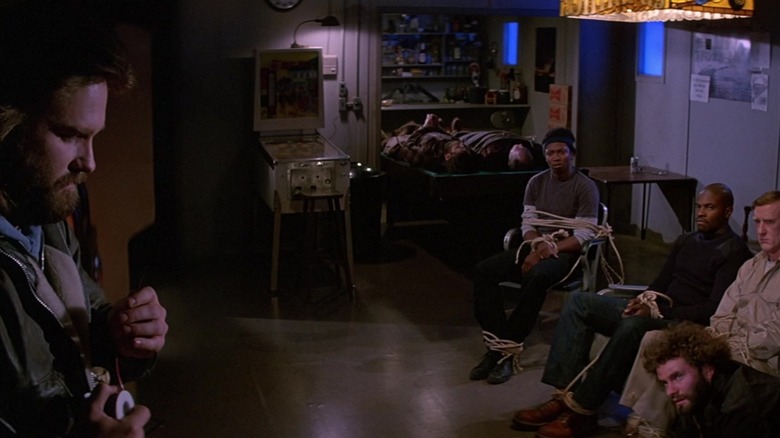This post contains spoilers for “The Thing.”
There are several stand-out sequences in John Carpenter’s cult classic “The Thing.” The opening itself, where a Norwegian helicopter pursues a sled dog and attempts to shoot it, immediately sets the tone for this morbid tale enmeshed in distrust and paranoia. What initially feels like a senseless attempt at violence (or a classic case of humans behaving irrationally due to extreme isolation) is gradually revealed to be a sincere endeavor to rid the world of an evil force that can morph into people we know and trust. The inhabitants of the Antarctic research station feel helpless in the face of such a perfect organism — one that can mimic, adapt, and deceive at will — but the most cynical among them, MacReady (Kurt Russell), comes up with a litmus test to prove everyone’s humanity and lure out the pretender.
The method employed is rather crude, but it accomplishes the goal anyway: a red-hot wire is dipped into blood samples on Petri dishes, with the intent to figure out if the creature’s self-preservative instincts would react to such intrusion. Uncontaminated human blood would merely make the wire fizzle, but a mutated sample would respond violently to such a perceived attack … and it does. Although MacReady’s extreme (yet understandable) method doesn’t quite go according to plan, resulting in some innocent deaths, the culprit is eventually lured out, thrashing grotesquely in a bid to shield itself from harm.
This tense, memorable sequence was the impetus behind Carpenter helming “The Thing,” as it presented a unique opportunity to remake Christian Nyby’s “The Thing from Another World” (along with adapting its brilliant source material, “Who Goes There?”) while also allowing Carpenter to put his singular spin on it.
The Thing’s blood-test scene was a chance to do something special
John W. Campbell’s horror novella “Who Goes There?” narrows down the hunt for The Thing when MacReady realizes that even small pieces of the creature assimilated into different bodies will behave as independent organisms. To test this theory, he conducts a base-wide blood test, leading to the deaths of 14 men who are revealed to be contaminated. By narrowing the scope of the pretender, Carpenter amps up the paranoia embedded into the sequence, as every individual, including those uncontaminated, is hostile toward MacReady for his brash methods, making us suspect everyone, including MacReady himself.
In an interview with The Guardian, Carpenter talked about his love for the scene, as he finally had the means to bring this tense sequence to life without having to compromise on any creative aspect — something that was not always possible due to the budgetary restrictions of an indie set:
“One of my favorite films was ‘The Thing From Another World.’ The idea of remaking it was daunting but exciting. This was also my first studio movie so many things were at my disposal –- it was very different to independent film-making where you have to scrounge around. The blood-test scene is the reason I did the movie. I thought I could do something special with it.”
Meticulous detail was carved into the core of the sequence, as the pretender, Palmer (David Clennon), is the only character without “that little sparkle that we use most of the time on characters to create the sense of life, of intelligence,” as cinematographer Dean Cundey revealed to SYFY Wire while talking about how Palmer’s eyes are devoid of reflected light in this scene. This small yet pivotal detail is essential to helping the audience identify which character is The Thing in this sequence — although it doesn’t do much to shed light on the film’s hopelessly bleak ending and its significance with regard to the fate of the world once the end credits start rolling.




